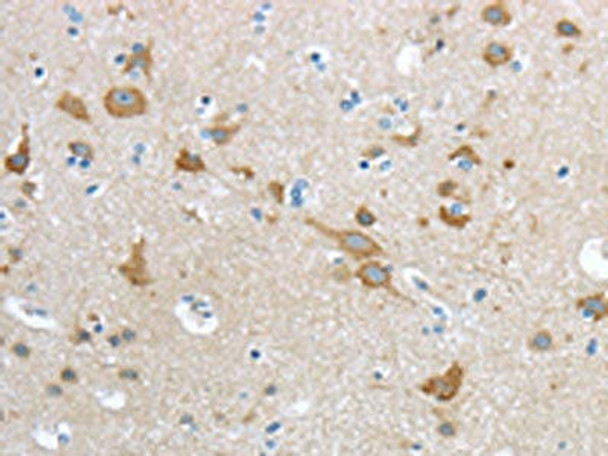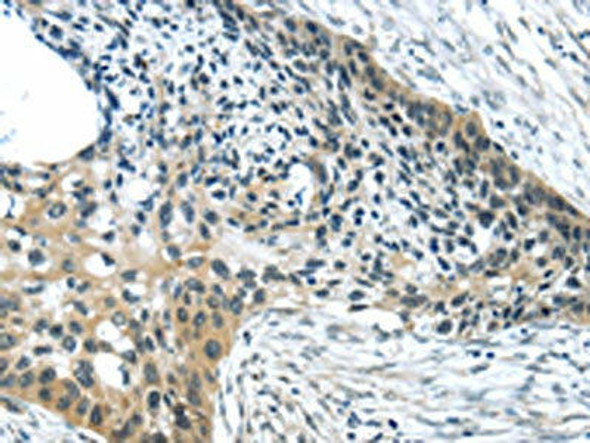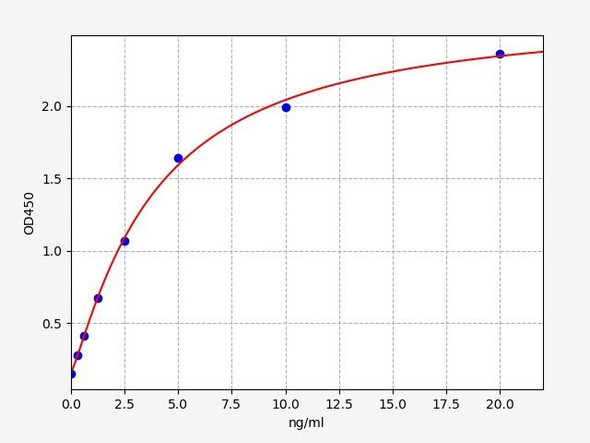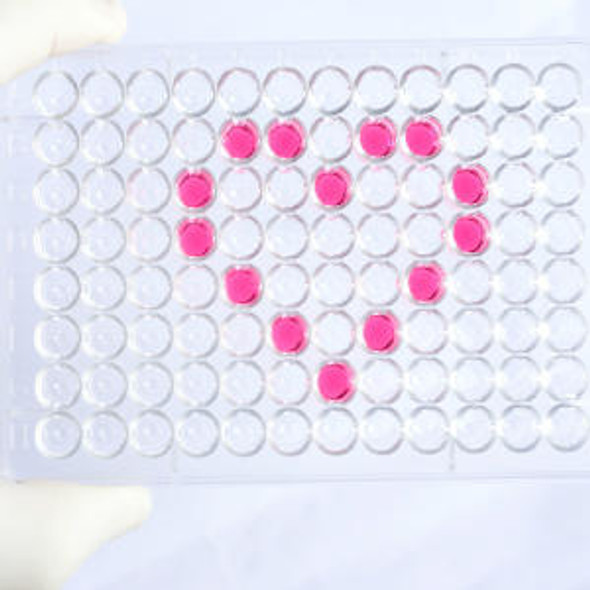HCN4 Antibody (PACO18050)
- SKU:
- PACO18050
- Product type:
- Antibody
- Reactivity:
- Human
- Mouse
- Rat
- Host Species:
- Rabbit
- Isotype:
- IgG
- Application:
- ELISA
- Application:
- IHC
- Antibody type:
- Polyclonal
- Conjugation:
- Unconjugated
Frequently bought together:
Description
| Antibody Name: | HCN4 Antibody (PACO18050) |
| Antibody SKU: | PACO18050 |
| Size: | 50ul |
| Host Species: | Rabbit |
| Tested Applications: | ELISA, IHC |
| Recommended Dilutions: | ELISA:1:1000-1:2000, IHC:1:10-1:50 |
| Species Reactivity: | Human, Mouse, Rat |
| Immunogen: | Synthetic peptide of human HCN4 |
| Form: | Liquid |
| Storage Buffer: | -20°C, pH7.4 PBS, 0.05% NaN3, 40% Glycerol |
| Purification Method: | Antigen affinity purification |
| Clonality: | Polyclonal |
| Isotype: | IgG |
| Conjugate: | Non-conjugated |
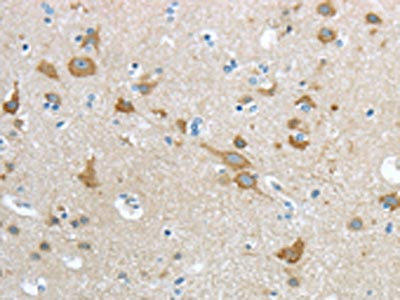 | The image on the left is immunohistochemistry of paraffin-embedded Human brain tissue using PACO18050(HCN4 Antibody) at dilution 1/20, on the right is treated with synthetic peptide. (Original magnification: x200). |
| Background: | This gene encodes a member of the hyperpolarization-activated cyclic nucleotide-gated potassium channels. The encoded protein shows slow kinetics of activation and inactivation, and is necessary for the cardiac pacemaking process. This channel may also mediate responses to sour stimuli. Mutations in this gene have been linked to sick sinus syndrome 2, also known as atrial fibrillation with bradyarrhythmia or familial sinus bradycardia. Two pseudogenes have been identified on chromosome 15. |
| Synonyms: | hyperpolarization activated cyclic nucleotide gated potassium channel 4 |
| UniProt Protein Function: | HCN4: Hyperpolarization-activated ion channel with very slow activation and inactivation exhibiting weak selectivity for potassium over sodium ions. May contribute to the native pacemaker currents in heart (If) and in neurons (Ih). Activated by cAMP. May mediate responses to sour stimuli. Defects in HCN4 are a cause of sick sinus syndrome type 2 (SSS2); also known as atrial fibrillation with bradyarrhythmia or familial sinus bradycardia. The term 'sick sinus syndrome' encompasses a variety of conditions caused by sinus node dysfunction. The most common clinical manifestations are syncope, presyncope, dizziness, and fatigue. Electrocardiogram typically shows sinus bradycardia, sinus arrest, and/or sinoatrial block. Episodes of atrial tachycardias coexisting with sinus bradycardia ('tachycardia-bradycardia syndrome') are also common in this disorder. SSS occurs most often in the elderly associated with underlying heart disease or previous cardiac surgery, but can also occur in the fetus, infant, or child without heart disease or other contributing factors, in which case it is considered to be a congenital disorder. Defects in HCN4 are the cause of Brugada syndrome type 8 (BRGDA8). A tachyarrhythmia characterized by right bundle branch block and ST segment elevation on an electrocardiogram (ECG). It can cause the ventricles to beat so fast that the blood is prevented from circulating efficiently in the body. When this situation occurs (called ventricular fibrillation), the individual will faint and may die in a few minutes if the heart is not reset. Belongs to the potassium channel HCN family. |
| UniProt Protein Details: | Protein type:Membrane protein, multi-pass; Membrane protein, integral; Channel, cation Chromosomal Location of Human Ortholog: 15q24.1 Cellular Component: integral to membrane; intrinsic to plasma membrane; perinuclear region of cytoplasm; plasma membrane Molecular Function:cAMP binding; identical protein binding; intracellular cAMP activated cation channel activity; voltage-gated potassium channel activity; voltage-gated sodium channel activity Biological Process: blood circulation; cation transport; muscle contraction; regulation of heart rate; regulation of membrane potential; synaptic transmission Disease: Brugada Syndrome 8; Sick Sinus Syndrome 2, Autosomal Dominant |
| NCBI Summary: | This gene encodes a member of the hyperpolarization-activated cyclic nucleotide-gated potassium channels. The encoded protein shows slow kinetics of activation and inactivation, and is necessary for the cardiac pacemaking process. This channel may also mediate responses to sour stimuli. Mutations in this gene have been linked to sick sinus syndrome 2, also known as atrial fibrillation with bradyarrhythmia or familial sinus bradycardia. Two pseudogenes have been identified on chromosome 15. [provided by RefSeq, Oct 2008] |
| UniProt Code: | Q9Y3Q4 |
| NCBI GenInfo Identifier: | 38605641 |
| NCBI Gene ID: | 10021 |
| NCBI Accession: | Q9Y3Q4.1 |
| UniProt Secondary Accession: | Q9Y3Q4,Q9UMQ7, |
| UniProt Related Accession: | Q9Y3Q4 |
| Molecular Weight: | 129,042 Da |
| NCBI Full Name: | Potassium/sodium hyperpolarization-activated cyclic nucleotide-gated channel 4 |
| NCBI Synonym Full Names: | hyperpolarization activated cyclic nucleotide gated potassium channel 4 |
| NCBI Official Symbol: | HCN4 |
| NCBI Official Synonym Symbols: | SSS2 |
| NCBI Protein Information: | potassium/sodium hyperpolarization-activated cyclic nucleotide-gated channel 4 |
| UniProt Protein Name: | Potassium/sodium hyperpolarization-activated cyclic nucleotide-gated channel 4 |
| Protein Family: | Potassium/sodium hyperpolarization-activated cyclic nucleotide-gated channel |
| UniProt Gene Name: | HCN4 |
| UniProt Entry Name: | HCN4_HUMAN |
| ELISA Kits |
| Human HCN4 ELISA Kit |
| Human Potassium/sodium hyperpolarization-activated cyclic nucleotide-gated channel 4 (HCN4) ELISA Kit |
| Secondary Antibody |
| Anti-HRP Goat Anti-Rabbit IgG (H+L) Antibody (CABS014) |
| Recommended Products |
| Anti-FITC Goat Anti-Rabbit IgG (H+L) Antibody (CABS011) |
| Anti-HRP-conjugated Beta Actin Antibody (CABC028) |

